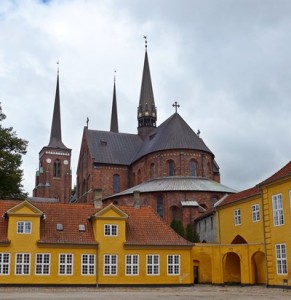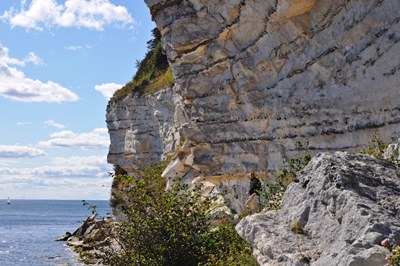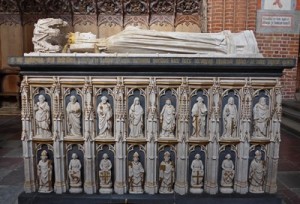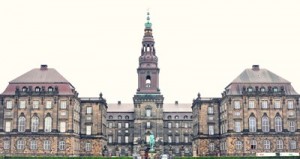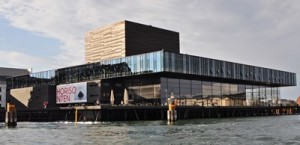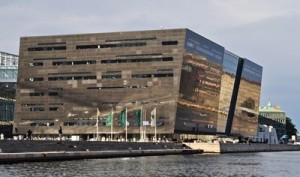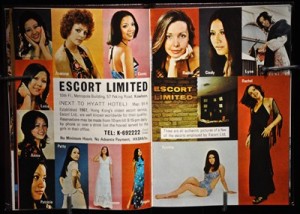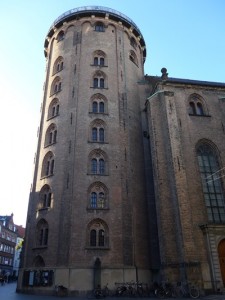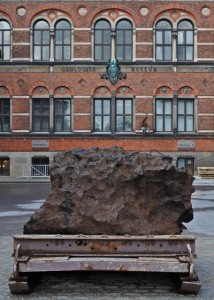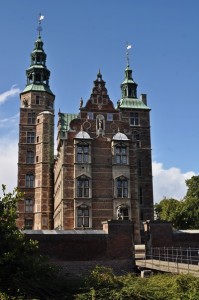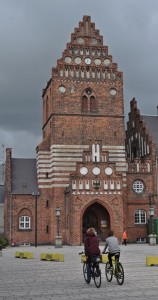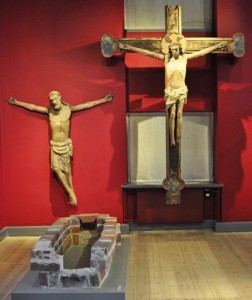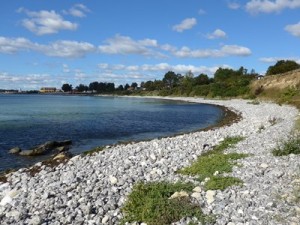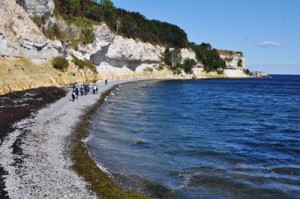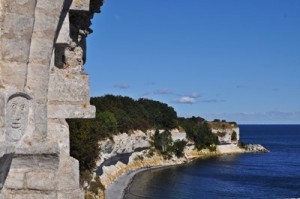|
|
September 2 Wednesday: Aasiaat (GMT-3)– Kangerlussuaq – Copenhagen (GMT+1)
![denmarkmap[1]](http://www.sarahontheroad.hk/wp-content/uploads/2015/09/denmarkmap1-212x300.gif) Everything went smoothly. I left Aasiaat on a chartered flight around 10:30am, arrived in Kangerlussuaq thirty minutes later and boarded an Air Greenland flight by noon. I was already at the Copenhagen airport shortly after 8pm. I said good-bye to Denis and my energetic and sociable boat-mates for the last ten days before leaving the airport. Randi and her mom, my Danish friends gave me a lift and I arrived at Urban House by 10pm. Given the time difference, I could not sleep till 3am (which is 11pm in Greenland).
Everything went smoothly. I left Aasiaat on a chartered flight around 10:30am, arrived in Kangerlussuaq thirty minutes later and boarded an Air Greenland flight by noon. I was already at the Copenhagen airport shortly after 8pm. I said good-bye to Denis and my energetic and sociable boat-mates for the last ten days before leaving the airport. Randi and her mom, my Danish friends gave me a lift and I arrived at Urban House by 10pm. Given the time difference, I could not sleep till 3am (which is 11pm in Greenland).
Denmark
The Kingdom of Denmark today is a sovereign state comprising Denmark and two autonomous constituent countries – the Faroe Islands and Greenland. Denmark proper with an area of 43,094 km² has been inhabited since around 12,500 BC. Agriculture has been evident since 3900 BC.
Denmark forms part of the cultural region called Scandinavia, together with Sweden and Norway and has interlocking history. From the 8th to 10th century, the Danes, Norwegians and Swedes were known as Vikings who colonised, raided and traded in all parts of Europe. Viking explorers discovered Iceland in the 9th century, reached the Faroe Islands, Greenland before crossing the Atlantic to reach the present day Newfoundland in Canada.
The unified kingdom of Denmark was founded by the Viking kings Gorm the Old and Harold Bluetooth in the 10th century, making the monarchy of Denmark the oldest in Europe. In 1397, Denmark entered into a personal union with Norway and Sweden, united under Queen Margaret I. In 1523, Sweden broke away and Denmark entered into a union with Norway which was resolved by the Treaty of Kiel in 1814.
Originally an elective monarchy, it became hereditary (i.e. absolute monarch) in 1660 during the reign of Frederick III. Following the adoption of the first Constitution of Denmark in 1849, it transformed into a constitutional monarchy.
Today, Denmark with a population of 5,678,358 (July 2015), has a highly developed mixed economy and modern nation running on a welfare state model. It joined the European Union in 1973 but retains its own currency, Danish krone (DKK). It enjoys a high standard of living with an estimate of GDP(PPP) and per capita in 2015 at $255.866 billion and $45,451 respectively. It also ranks highly in numerous comparisons of national performance including education, health care, protection of civil liberties, human development, democratic governance, social mobility, income equality and happiness.
September 3 Thursday: Christianshavn & Canal cruise
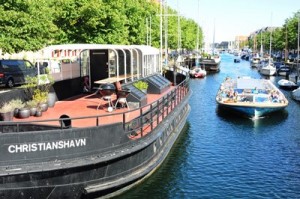 I had five full days to spend in Denmark. Hence I brought a 120-hour Copenhagen Visitor Card for DKK799 first thing in the morning. The card enables a holder to use public transport free of charge (bus, harbour buses, Metro and train) throughout Greater Copenhagen and free admissions to 74 museums and attractions.
I had five full days to spend in Denmark. Hence I brought a 120-hour Copenhagen Visitor Card for DKK799 first thing in the morning. The card enables a holder to use public transport free of charge (bus, harbour buses, Metro and train) throughout Greater Copenhagen and free admissions to 74 museums and attractions.
What have I done with the card? Quite a lot but not enough! I highlight and number the places I have visited with the card.
I walked to Church of Our Saviour (1752) on Christianshavn. This church built in Dutch baroque style with a layout of a Greek cross, is famous for its helix spire with an external winding staircase. I activated the card at 11:15am in order to climb the 400 steps to the top (1). The Saviour stands on his golden globe keeping watch over the Queen’s Copenhagen. It is an exhausting climb. But the panoramic views over the capital is breathtaking and worth the effort.
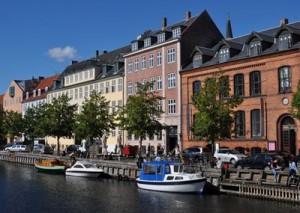 |
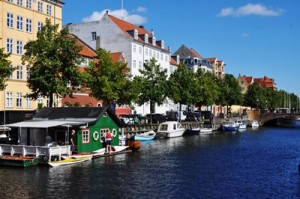 |
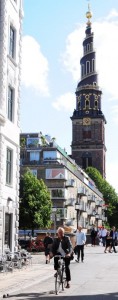 |
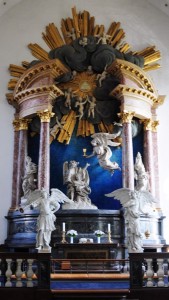 |
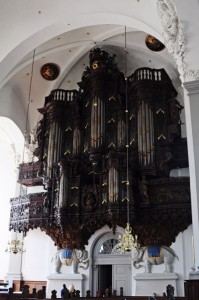 |
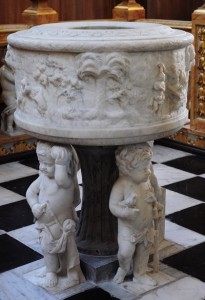 |
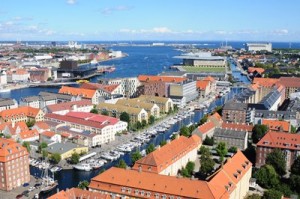 |
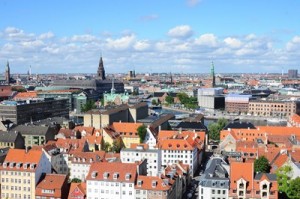 |
Interior of the church is worth looking. The altarpiece by Nicodemus Tessins depicting a scene from the Garden of Gethsemane is a masterpiece. The huge and impressive organ with more than 4000 pipes and Christian V’s gilded monogram, is mounted on the wall supported by two elephants.
Then I walked to the Castle Island which has many attractions. Here I picked the Christiansborg Palace (2), the Royal Stables (3), the Ruins (4) and the Thorvaldsens Museum (5).
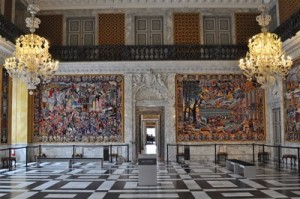 |
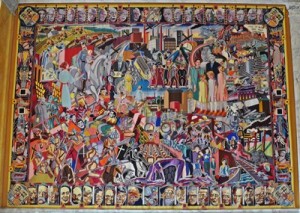 |
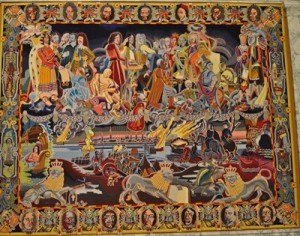 |
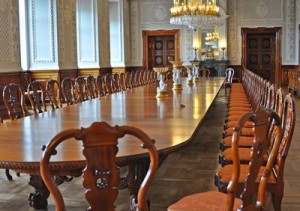 |
Two castles and three palaces have been built on this site. Absalon’s Castleoccupied by the Bishop of Roskilde was the first one erected in 1167. After the demolition of the castle by the Hansa League in 1369, a new stronghold, Copenhagen Castle was built. In 1417, King Eric VII took over the castle from the Bishop and it became the principal residence of the Danish kings and the centre of government.
In 1720s, Frederick IV entirely rebuilt the castle which was so heavy that the walls cracked. His successor, Christian VI rebuilt and expanded it to become the largest palace in Europe at the time. But the palace and church was ruined by a fire in 1794.
Work on the second Christiansborg started in 1803 and King Frederick VII was the only monarch to live in the palace between 1852-1863. After the introduction of the constitutional monarchy following the adoption of Constitution of 1849, the south wing of the palace became the meeting place of the two houses of the first Danish Parliament. It was again burnt down in 1884. The third and current Christiansborg in neo-baroque style was built from 1907-1928. I had a tour of the first floor to see the Royal Reception Rooms, Great Hall, Dining Hall, Library, the Tower Hall which displays a series of modern and colourful tapestries with motifs from Danish folk songs, woven after cartoons painted by Joakim Skovgaard. Under the palace lie the ruins of Bishop Absalon’s Castle and Copenhagen Castle which were discovered during the construction of the present building.
I left Christiansborg shortly after 5pm. The weather began to clear up and I decided to take a one-hour canal cruise (6). It’s the first time I look at Christianshavn. Little Mermaid and the harbour developments including the Opera House and National Theatre from a boat.
September 4 Friday: Helsingbørg & Humlebaek
I took a train to Helsingbørg in order to visit the Kronborg Castle (7), a World Heritage Site. Situated on the extreme northeastern tip of the island of Zealand at the narrowest point of the Øresund, the sound between Denmark and Sweden, Kronborg, one of the most important Renaissance castles in Northern Europe, has been immortalised as Elsinore in Shakespearer’s play Hamlet.
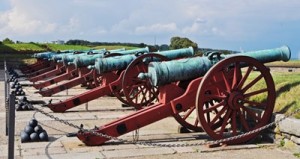 |
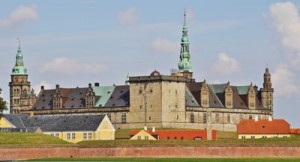 |
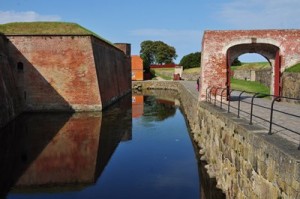 |
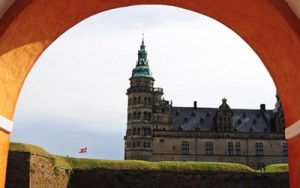 |
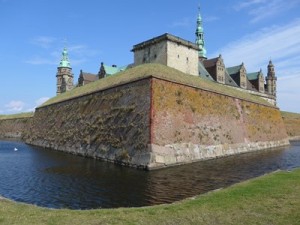 |
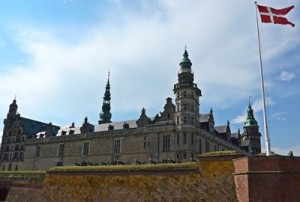 |
First built by King Eric VII in 1420s, the castle was radically transformed into a magnificent Renaissance castle during King Frederick II’s reign (1574-1585). Much of the castle was destroyed by a fire in 1629. King Christian IV had it rebuilt. In 1658, Kronborg was besieged, captured and looted by the Swedes. In 1785, the castle ceased to be a royal residence and was converted into barracks for the army which left in 1923. It was opened to the public in 1938.
It was drizzling when I set off in the morning. By 10am, the weather had improved with brilliant sunshine and clear blue sky. I had to climb endless staircases in order to reach all corners of the castle to see the Royal Apartments, Ballroom (measuring 62×12 metres and decorated with many large paintings) and Little Hall (with seven out of a series of 40 tapestries portraying one hundred Danish kings). But I like the Chapel and enjoy wandering around in the atmospheric prison with dark passages and cells.
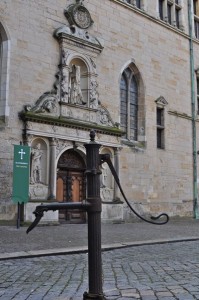 |
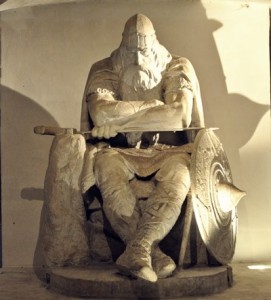 |
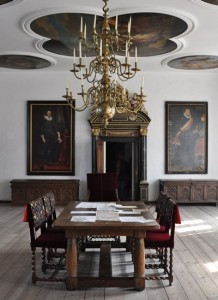 |
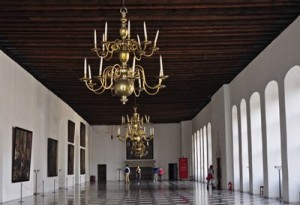 |
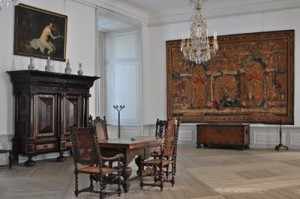 |
Close to the castle is the Danish Maritime Museum(8) which collections cover Danish trade and shipping from 1400 to the present day. The museum was located at the Kronborg Castle till 2013 when it moved into the new underground premises around a former dry dock.
Denmark is a great maritime nation and this award-winning museum has rich collections of model ships, paintings, photographs and artifacts relating to navigation, shipbuilding, sailor’s life etc. Worth visiting.
I was back in the train station before 3pm hoping to take a local train to Hillrød and arrive at the Frederiksborg Castle before 4pm. Unfortunately something was wrong with the train and by 4pm, I was still stuck in the train nowhere near Hillrød.
I changed plan and took another train to go to the Louisiana Museum of Modern Art (9) which closes late on Thursday. I have made the right decision: the museum has a special exhibition on Africa: Architecture, Culture and Identity. I have been to some 20 countries in Africa and am aware of problems associated with urbanisation, population growth, lack of planning and proper infrastructures. There is a good collection of paintings by Asger Jorn (1914-1973) and works by Henry Moore (1898 – 1986) and Alberto Giacometti (1901 – 1966).
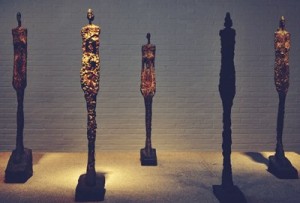 |
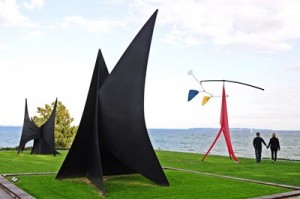 |
The sun was setting. I enjoyed strolling leisurely in the sculpture garden featuring several works of Henry Moore and looking at the sea. I stayed in the museum till almost 7pm.
September 5 Saturday: Copenhagen
As Urban House was fully booked from September 5 to 8, I had to move to Generator, another popular designed and themed hostel located half way between Nørreport and Kongens Nytorv. The area is lively with lots of eateries, pubs and design shops. I also note some new and redevelopment projects in the vicinity. The weather in the morning was bad with dark sky and heavy rain at times. I therefore spent most of the day indoor.
It is a nice and short walk from Generator to the Rosenborg Castle (10), built in Dutch Renaissance style and one of an example of Christian IV’s many architectural projects. It had been expanded several times and evolved into its present condition by 1624. Amongst the main attractions in the Long Hall are the coronation chair of the kings and the throne of the queens with three silver lions standing in front and 12 tapestries depicting Christian V’s victories in the Scanian War (1675-79). I find the castle too ornate and dark to my liking. But the Treasury exhibiting the Royal Collections and Crown Jewels though small has impressive collections.
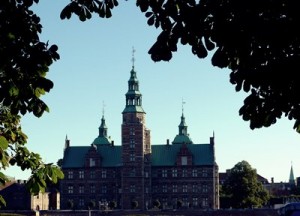 |
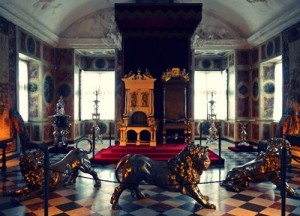 |
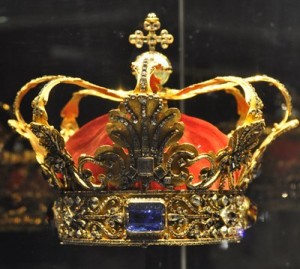 |
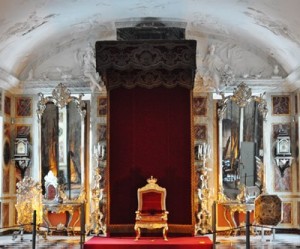 |
Across the road is the Geology Museum (11) which has been highly recommended by Denis, the geologist on Rembrandt. I had a revision on asteroid and meteoroid and see a remarkable collection of rocks and minerals.
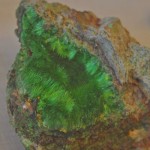 |
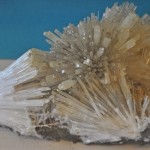 |
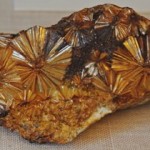 |
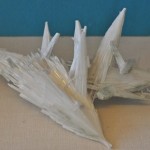 |
Close to the Geology Museum is SMK (12), Denmark’s largest art museum and national gallery. It’s the first time I have seen such a large and impressive collection of works by Danish artists including Asger Jorn, Emil Nolde and Anton Kannemeyer. In addition there are many paintings by European painters. I could have spent a few hours here. But I wanted to get out for fresh air.
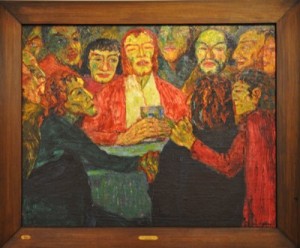 |
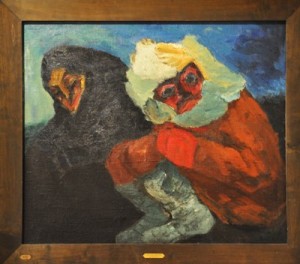 |
The weather had improved. Hence, I planned to visit Ordrupgaard which has a good collection of French Impressionist art and Danish art. Above all, I want to see the new wing of the museum designed by Zaha Hadid and the outdoor Art Park. Unfortunately, I got off at the Ordrup station instead of the last station at Klampenborg. When I discovered my mistake when I could not find the connecting bus, it was too late to walk back to the station and wait for the next train.
I returned by bus to Copenhagen and spent a couple of hours wandering aimlessly looking at the stylish window design of fashion and furniture shops. Copenhagen has changed a lot since my first visit in 1980. It has its own charm: not as clinically clean and tidy as Switzerland or its Scandinavian neighbours but a lively and colourful centre and harbour.
By chance, I reached and visited another project by Christian IV, the Round Tower (13). It was built as an astronomical observatory with a most impressive equestrian staircase, a 7.5-turn helical corridor leading to the top. When it was first built, it was the tallest building affording excellent views over Copenhagen. No more! However, I find an interesting exhibition called “Dark Angels” showing costumes by fashion house Peachoo + Krejbug (2004 – 2014)!
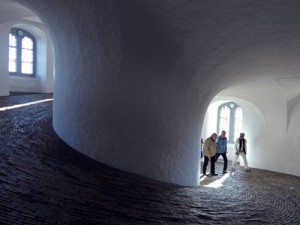 |
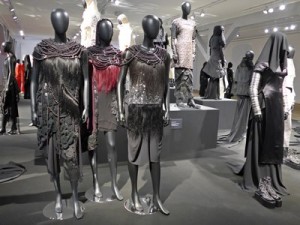 |
September 6 Sunday: Roskilde
Today’s highlight was the Roskilde Cathedral, which has been inscribed on the UNESCO World Heritage List because “it is an outstanding example of one of the earliest major ecclesiastical buildings in brick. In 12th century Europe brick was a new building material, and Roskilde Cathedral had a profound influence on the spread of brick in Northern Europe”. It is also “an exceptional example of the evolution of European architectural styles in a single structure”.
I had to take the train to Roskilde and got there around 11am. When I arrived, the Sunday service was still in progress and the Cathedral would be open for visitors after 12:30pm. Anyway, I sat down and watched the service.
|
|
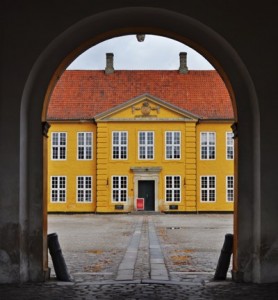 |
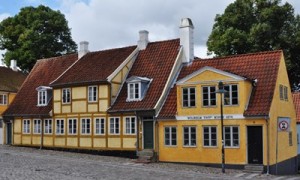 |
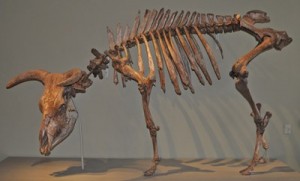 |
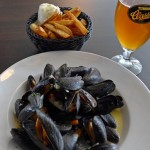 I wandered around the town and visited the Roskilde Museum (15) which exhibits artifacts from the area. Then I had a lovely Sunday lunch with local blue mussels and a beer at the Prindsen Hotel for less than DKK200.
I wandered around the town and visited the Roskilde Museum (15) which exhibits artifacts from the area. Then I had a lovely Sunday lunch with local blue mussels and a beer at the Prindsen Hotel for less than DKK200.
I then returned to the Cathedral and spent almost two hours there.The first church on the site was built by Harold Bluetooth who died in 985. The wooden church was replaced by a stone church sometime in the 1000s. Construction of the present brick church was started in the 1170s under Bishop Absalon(1158-1201) and took over 100 years to complete. It was Scandinavia’s first Gothic cathedral built in brick and this style spread throughout northern Europe.
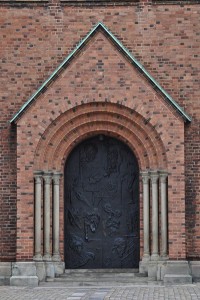 |
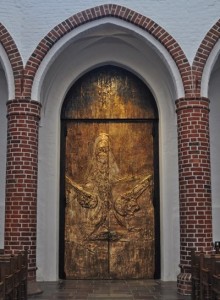 |
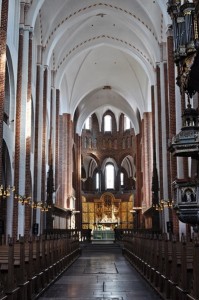 |
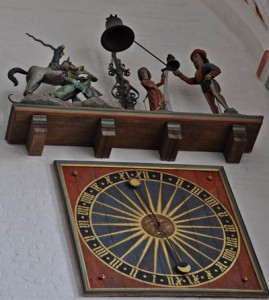 |
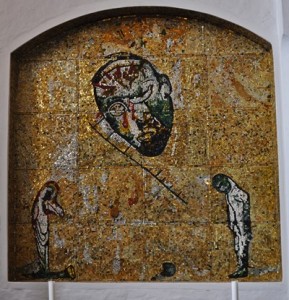 |
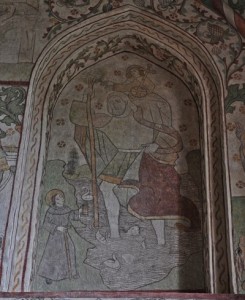 |
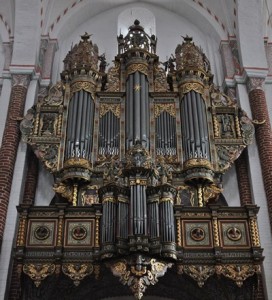 |
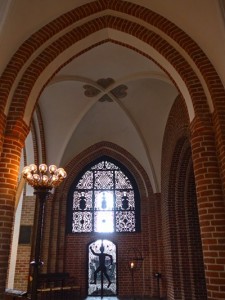 |
It has also been the last resting place of the Danish royal family since the 15th century: almost Danish kings and queens (with only one exception since the reformation) were buried in the Cathedral. Porches and side chapels were added up to the end of the 19th century. It therefore provides a clear overview of the development of European religious architecture and the evolution of funerary monumental art.
All visitors are given a free beautiful guide book with photos and illustrations. Interior of northern European churches are normally bright and airy, serene and peaceful but not stuffy and melancholic. I walked slowly through this royal mausoleum which is like a museum learning more about the history of Denmark and the royal family!
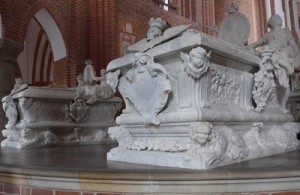 |
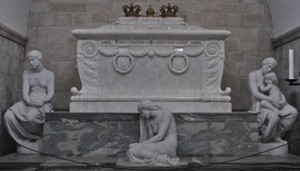 |
- Margrethe I who died in 1412 was buried immediately behind the high altar signifying her importance in history.
- The four royal burial chapels namely the Chapel the Magi (Christian I’s Chapel), Christian IV’s Chapel, Frederick V’s Chapel and Christian IX’s Chapel all have different design and feel.
- A few were buried in the choir, while the burial site of Frederick IX(d.1972) and Queen Ingrid of Sweden (d. 2000)was outside the cathedral.
- St Birgitta’s Chapel will house the future sepulchral monument for the present royal couple (Queen Margrethe II and Prince Henrik). A model of the glass sarcophagus is already on display in the chapel.
What a stately but cool, beautiful and economical way to honour a royal family! Apart from monumental burial art, the Cathedral is full of treasures including the exquisitely carved Christian IV’ private box, the organ, the King’s door, the clock from 15th century and the pulpit.
After Roskilde, I returned to Copenhagen and went to the National Aquarium Denmark (Blue Planet)(16) opened in 2013. It was pouring with rain when I reached it just before 5pm. I spent an hour looking at the five main sections namely the Rainforest, African Great Lakes, Evolution and Adaption, Warm Ocean and Cold Water. To walk through the 16metre-long shark tunnel is fun.
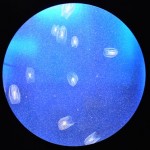 |
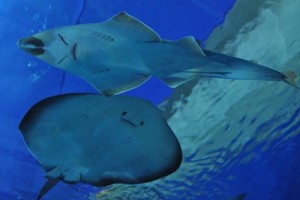 |
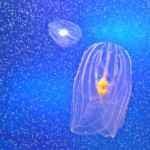 |
September 7 Monday: Stevns Klint – Frederiksborg Castle
I had to make a long trip in order to visit Stevns Klint, a natural World Heritage Site. It is a white chalk cliff rising to a height of up to 40m and located some 6km from Store Heddinge. Stretching 14.5km along the coast, it is of geological importance as one of the best exposed Cretaceous-Tertiary boundaries in the world.
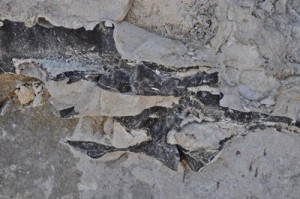 |
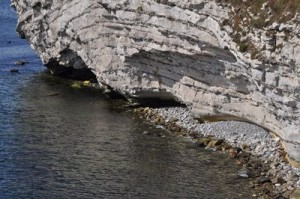 |
The cliff reveals sections from the uppermost part of the Maastrichtian stage (72 to 66 million years ago) and from the lowermost part of the Danian stage (66 to 62 million years ago). It is an outstanding visible record of the mass extinction at the end of the Cretaceous period: a black layer of fish clay, a few centimetres thick, containing iridium clearly marks the Cretaceous-Paleogene boundary.
I spent over two hours taking two train rides: first a S-train from Nørreport to Køge and then another local train. The train conductor suggested me get off in Rødvig (the last stop) and walk along the Stevns Klint path.
The road sign is a bit confusing at the starting point in Rødvig. I thought the path is along the coast and headed to the beach/coast which affords good views of the cliff. I walked for almost a kilometre and could not go further unless I was prepared to wade through the shallow water below the cliff. Not knowing what lies beyond the bend, I turned back and asked a local sitting in his garden above the beach for direction. He kindly let me go through his garden to get back to the main path.
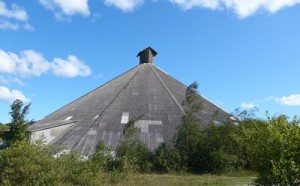 |
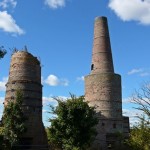 |
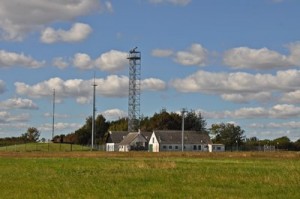 |
I followed the path above the cliff for some 4-5 km passing a few lookout points and the Cold War Museum. This top secret large underground fortress was built in 1953 and remained operational till 2000. which was built I did not have time and gave the museum a miss. Finally I arrived at the old Højerup Church which stands at the top of the cliff dating from the year 1200. As a result of erosion, a landslide in 1928 caused the chancel to collapse and fall to the shore below.
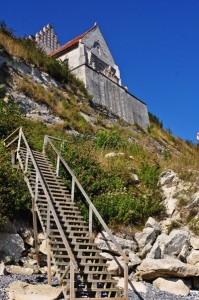 |
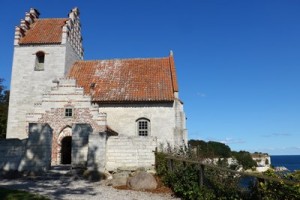 |
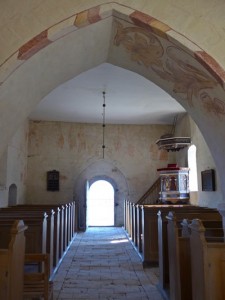 |
A steep staircase with about 100 steps leads to the beach. From the bottom of the cliff, I had a good view of the cliff. I had to climb over many boulders in order to get close to the cliff to see the fish clay.
By the time I came up from the cliff and visited the old church, it was about 1:20pm. I stopped at the Stevns Klint Museum with some illustrations of the local history and the geology of the cliff. The lady of the museum told me the local bus to Køge would leave at 1:41pm. Hence I had a cursory look at the exhibits before rushing off to the bus stop. It was about 1:37pm but the bus was for 1:35 and not 1:41pm. The next bus would be at 2:35pm! I was annoyed but nothing I could do but wait.
After having a sandwich in a local pond, I walked back to the bus stop and sat on the pavement waiting for the bus shortly after 2pm. A car stopped in front of me and offered to take me to the Store Heddinge station. I was lucky as I managed to catch the 2:23pm train to Køge.
Frederiksborg Castle built as a royal residence of Christian IV in the early 17th century is till on my wish list. I therefore tried to reach it before it closed at 5pm. Unfortunately, it took me an hour to return to Copenhagen, 45 minutes by train to Hillrød and 15 minutes to walk to the castle. It was 4:50pm.
 Situated on three islets in the castle lake, the castle is adjoined by a large formal garden in the Baroque style. After a serious of fire in 1859, the castle was rebuilt on the basis of old plans and paintings. Now it is used as the Danish Museum of National History with the largest collection of portrait paintings in Denmark. The Chapel and the Audience Chamber which were largely spared by the fired and contain sumptuous decorations are also open to the public. As I had less than ten minutes, I only asked the receptionist to let me see the famous chapel (17) consecrated in 1617. It is the best preserved part of the Renaissance complex with richly decorated six-vaulted stucco ceiling and Denmark’s oldest organ built by Esajas Compenius in 1610 with 1,001 wooden pipes.
Situated on three islets in the castle lake, the castle is adjoined by a large formal garden in the Baroque style. After a serious of fire in 1859, the castle was rebuilt on the basis of old plans and paintings. Now it is used as the Danish Museum of National History with the largest collection of portrait paintings in Denmark. The Chapel and the Audience Chamber which were largely spared by the fired and contain sumptuous decorations are also open to the public. As I had less than ten minutes, I only asked the receptionist to let me see the famous chapel (17) consecrated in 1617. It is the best preserved part of the Renaissance complex with richly decorated six-vaulted stucco ceiling and Denmark’s oldest organ built by Esajas Compenius in 1610 with 1,001 wooden pipes.
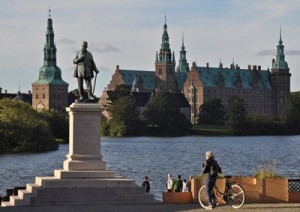 |
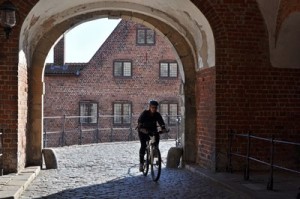 |
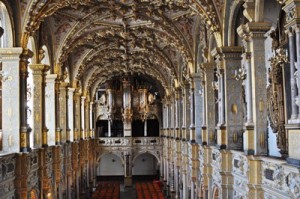 |
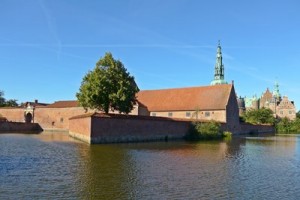 |
The castle was deserted when I came out. I enjoyed the tranquility while watching locals biking through the castle gates. Then I had a leisure walk through the town and an ice-cream. I was back in Generator before 7pm and had a drink with Randi in Nyhavn in the evening.
September 8 Tuesday: Copenhagen – Helsinki (GMT+2)
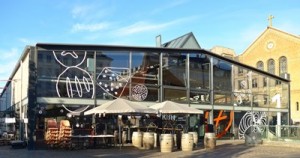 I had a good sleep, got up at 7am and had time to visit the market near Nørreport before going to the airport. The cafes were open but fish, vegetable and fruit stalls were still closed. There are many eateries in the market which is a popular night spot. I took the Metro and arrived at the airport around 9:30pm. By 1:30pm, I was on my way to Helsinki.
I had a good sleep, got up at 7am and had time to visit the market near Nørreport before going to the airport. The cafes were open but fish, vegetable and fruit stalls were still closed. There are many eateries in the market which is a popular night spot. I took the Metro and arrived at the airport around 9:30pm. By 1:30pm, I was on my way to Helsinki.
I am glad to have a chance to wander around the country and have a better understanding of its history, culture, people. Danes love cycling and the country is pedestrian friendly. I can feel its pulse, creativity and vibrancy and like the Danish design and lifestyle which nurtures creativity and healthy living.


